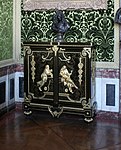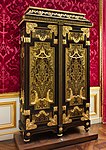Boullemarketerie

The concept of Boullemarketerie or Boulletechnik describes a technique from the craft of the carpenter , the surfaces of high-quality furniture and objets d'art to ennoble. The term includes the technique of marquetry used to manufacture it and the family name of a French cabinet maker , André-Charles Boulle . Colloquially, the term Boulle marquetry is used both for the technology used and as a concept of style .
development
The origins of Boullemarketerie go far before André-Charles Boulle. His merit lies in perfecting the craftsmanship of marquetry technology. One reason for its fame lies in the stylistic success of the arabesque and grotesque in the Louis quatorze style at the end of the 17th century. Many of the works made after 1710 use motifs by Jean Bérain the Elder . In 1707 André-Charles Boulle delivered the first furniture with Boullemarketeries to King Louis XIV for his bedroom in the small room ( Petit Apartment ) of the Palace of Versailles .
technology

The use of improved tools made faster and more precise production possible. The main feature of the marquetry named after Boulle is the use of tortoiseshell (and ebony ) in combination with brass or pewter . These are glued onto the furniture surface as a veneer .
A distinction is generally made between two contrasting design techniques. The shape of the première-partie with a dark background (tortoiseshell) and a light image (brass, tin) is generally the more valuable, if only because of the use of materials. Often the tortoiseshell is pigmented on the back on the side facing the body or has a colored paper behind it. Due to the costly natural products and elaborate processing, the negative created during production was processed as a contre-partie . Other motifs are often engraved on the parts made of metal .
Boulle Revival
... even Buhl work called
- during the Louis-seize
- during the Second Empire and Napoléon III.
- during the Belle Époque
gallery
- Boulle furniture
Medal cabinet by Boulle ( contre-partie ), in the Salon de l'Abondance , Palace of Versailles
Detail of a clock by André Charles Boulle, Metropolitan Museum of Art , New York
Boulle cabinet in the Metropolitan Museum of Art , New York.
Detail of the Boulle cabinet in the Metropolitan Museum of Art , New York.
Boulle marquetry, attributed to André-Charles Boulle, restored by René Dubois (1737–1798), ca.1705 and 1755–1798, Wallace Collection , London
Works (selection)
- 1684 chest cabinet de marqueterie en forme de tombeau in Boullemarketerie (countre-partie) based on motifs by Jean Louis Berain, made for Louis of France, Le Grand Dauphin (* 1661; † 1711), now in the State Apartments in Blenheim Palace and ( première-partie) and (countre-partie) in the Getty Museum in Los Angeles (Fig. see collections, link Getty Center) .
- 1719 Toilet mirror in Boulle Marketrie (première-partie) based on motifs by Jean Louis Berain, made for Marie Louise Élisabeth d'Orléans , Duchess of Berry, now in the Wallace Collection in London .
- 1720-1732 console in Boullemarketerie (première partie-) with Akantus- and flowering vines, made for the blue Kabinet of the apartments of the Empress Maria Amalia of Austria (* 1701, † 1756) in the Munich Residence , now in the Bavarian National Museum in Munich .
Collections
- Grand and Petit Apartment, Palace of Versailles
- Boughton
- Blenheim Palace
- Getty Center
- Louvre , Paris
- Waddeston Manor
- Wallace Collection Front, London
literature
- Chastang, Yannick 2002 Paintings in Wood: French Marquetry Furniture , London, Wallace Collection. (Catalog for the exhibition of the same name), ISBN 0-900785-66-7
- Feulner, Adolf 1927 Art history of furniture , Berlin, Propylaen publishing house.
- Hughes, Peter 2000 The Wallace Collection: Catalog of Furniture London, Wallace Collection. ISBN 0-900785-51-9
- Langer, Brigitte; Ottomeyer, Hans 1995 The furniture of the Munich Residence, I The French furniture of the 18th century , Munich, New York, Prestel.









